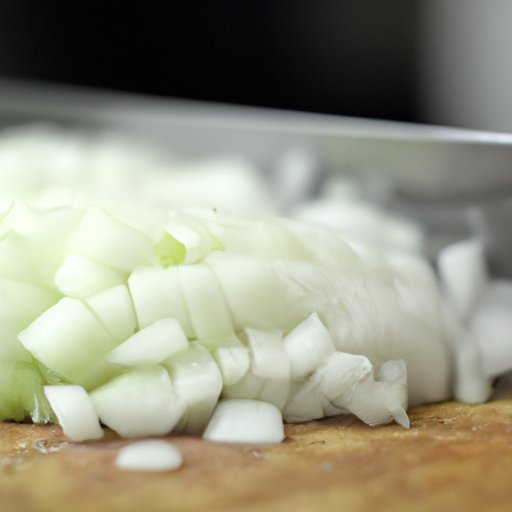
Introduction
If you’ve ever chopped an onion before, you know that it can be a frustrating and tear-filled experience. But fear not! In this article, we’ll provide you with a comprehensive guide on how to cut onions effectively and safely. Our step-by-step instructions will help you master the basic techniques, achieve perfect cuts every time, and avoid tears. We’ll also cover how to choose the right onion for your recipe, offer some creative onion hacks, provide delicious recipes that feature onions, and offer some general safety tips for working in the kitchen.
The Basics
The first step in cutting an onion is peeling it. Cut off the ends of the onion and remove the papery skin. Then, cut the onion in half from the root to the stem end. Place each half flat on the cutting board. Cut the onion vertically, taking care to leave the root end intact. Then, cut horizontally across the onion. This is the basic technique for dicing an onion.
The three main types of cuts that you can make when cutting onions are slicing, dicing, and mincing. Slicing is when you slice the onion into thin circles. Dicing is when you cut the onion into small cubes. Mincing is when you chop the onion into very small pieces. When selecting a type of cut, consider the recipe and the texture of the desired end product.
When cutting onions, it’s important to keep your knife sharp and choose the right type of knife for the job. A sharp knife will make cutting easier and more precise. A chef’s knife is a versatile option for cutting onions, but you may also prefer to use a smaller knife for more delicate work. Use a rocking motion with your knife when slicing onions to help make the cuts more precise and consistent.
Perfect Cuts
To achieve perfect slices or dices every time, you’ll want to focus on keeping your cuts even. Use your fingers to guide the knife and keep your cuts consistent. You’ll also want to make sure that you’re using a sharp knife, as a dull knife can cause more tearing and imprecise cuts.
A rocking motion can be especially helpful when slicing onions. This involves putting the tip of the knife on the cutting board and rocking the blade back and forth while making the cut. This can help you maintain a consistent angle and pressure on the knife, resulting in more precise and uniform slices.
Tear-Free
Tearing up while cutting onions is a common problem. Fortunately, there are several strategies for avoiding tears. For starters, be sure to use a sharp knife. The sharper your knife, the less likely it is to crush the onion cells and release the compounds that cause tearing. You can also chill the onion before cutting it, or cut it under running water to help reduce the amount of gas that’s released.
If you do start to tear up, try taking a break and stepping away from the onion. Rubbing your eyes with a cold, damp cloth can also help alleviate the symptoms.
Choosing the Right Onion
Not all onions are created equal. When selecting an onion for your recipe, consider the flavor and color that you want to achieve. Yellow onions are the most common and have a strong, pungent flavor. White onions have a milder flavor and a thinner skin. Red onions are sweeter and great for salads or sandwiches. Sweet onions are mild and ideal for grilling or roasting. Shallots have a delicate, sweet flavor and are great for use in sauces.
When cutting different types of onions, it’s important to adjust your techniques accordingly. Red onions, for example, are relatively soft and can be more difficult to slice than yellow onions. Shallots, on the other hand, are small and delicate and should be treated with care.
Onion Hacks
If you’re looking for some creative onion hacks, we’ve got you covered. One popular hack is to use a food processor to chop your onions. This can be a quick and easy way to get uniform pieces without all the hassle of hand chopping. Another hack is to freeze your onions before cutting them. This can help reduce the amount of gas that’s released and make the onion easier to peel. You can also try microwaving your onions for 30 seconds before cutting them. This can help soften the onion and make peeling easier.
Recipes
Onions are a staple in many different types of cuisine, from French Onion Soup to Indian curries. Here are a few recipes that prominently feature onions:
- French Onion Soup
- Caramelized Onion Tart
- Roasted Onion and Garlic Dip
When a recipe calls for caramelized or roasted onions, you’ll want to adjust your cutting techniques and cooking times accordingly. Caramelized onions require slow, gentle cooking to bring out their natural sweetness. Roasted onions can be cut into wedges or quarters and roasted until tender and slightly caramelized.
Safety Tips
Working with knives and vegetables can be dangerous if you’re not careful. To ensure your safety when cutting onions, be sure to follow these tips:
- Use proper hand positioning when holding the knife and the onion
- Use a stable cutting board
- Always use sharp knives
- Keep your fingers away from the blade while cutting
When disposing of onion scraps, make sure to put them in the compost bin or garbage can and wash your hands thoroughly afterward to avoid any cross-contamination.
Conclusion
Cutting onions is a skill that requires patience, practice, and the right techniques. By following our comprehensive guide, you’ll be able to master the basics of cutting onions, achieve perfect cuts every time, and avoid tears. With a little creativity and experimentation, you can also discover new hacks and recipes that feature onions in exciting and delicious ways. Above all, remember to prioritize safety when working with knives and vegetables.




